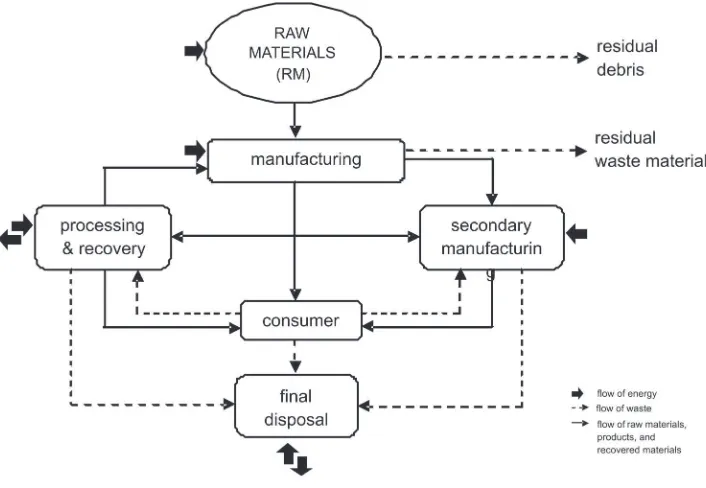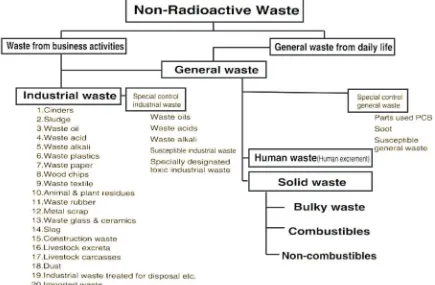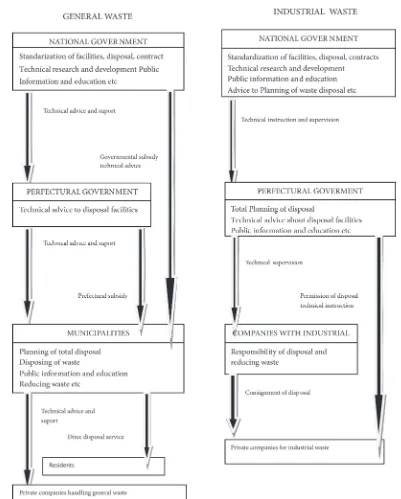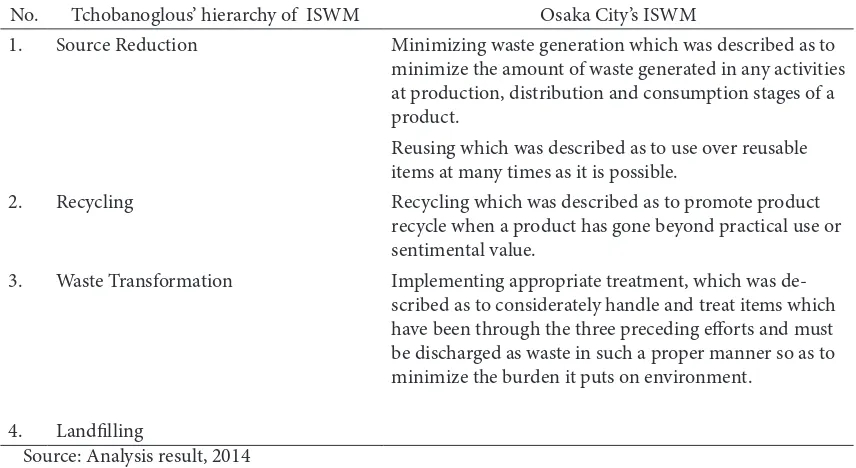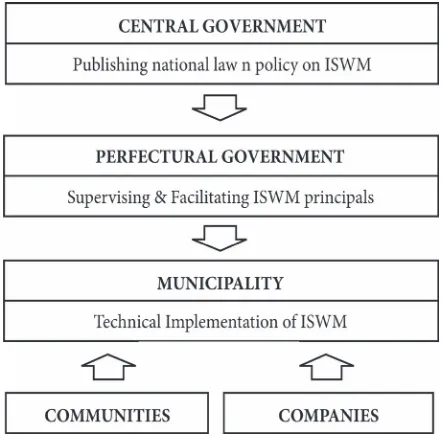IJG Vol. 46, No.2, December 2014 (187 - 194) © 2014 Faculty of Geography UGM and he Indonesian Geographers Association
Evaluating he Integrated Environmental Management Of
Munici-pal Solid Waste In Osaka City, Japan
Sintha Prima Widowati
Received: 29 10 2014 / Accepted: 31 10 2014 / Published online: 31 12 2014 © 2014 Faculty of Geography UGM and he Indonesian Geographers Association
Abstract Many state-of-the-art concepts and technologies on managing MSW have been developed for years. How-ever, in Indonesia, the practice may still be insuicient because of the institutional capacity issue. his study aimed to evaluate the integrated environmental management for municipal solid waste in Osaka City, Japan. Method in use was descriptive analysis by literature review using oicial document “Environmental Management in Osaka City for Fiscal Year 1999” by Osaka City Environmental Bureau. Result showed Osaka City was adopting and modifying the Integrated Solid Waste Management (ISWM) suggested by Tchobanoglous et al. [1993] hierarchically using “Waste Reduction Principles” and establishing “Environmental Management Bureau” to handle the integrated solid waste management practice. More importantly, the implementation of ISWM was completely supported by the central government by law which was he Waste Disposal and Public Cleaning Law and by regulation which was the task distribution among cen-tral, prefectural and municipal government in managing the solid waste. hese approaches were proven to be efectively implemented from top to bottom level thus should be recommended to the government of Indonesia.
Abstrak Berbagai macam konsep dan teknologi dalam mengelola sampah kota telah banyak dikembangkan selama berta-hun-tahun. Namun di Indonesia prakteknya masih belum sesuai karena permasalahan kapasitas kelembagaan. Penelitian ini bertujuan untuk mengevaluasi pengelolaan lingkungan terintegrasi untuk sampah di Kota Osaka, Jepang. Metode yang digunakan adalah analisis deskriptif dengan kajian pustaka menggunakan dokumen resmi “Environmental Management in Osaka City for Fiscal Year 1999” dari Osaka City Environmental Bureau. Hasil kajian menunjukkan bahwa Kota Osaka mengadopsi dan memodiikasi konsep “Integrated Solid Waste Management (ISWM)” milik Tchobanoglous [1993] secara hirarki menjadi prinsip-prinsip “Waste Reduction Principles” dan membentuk Osaka City Environmental Bureau un-tuk menangani implementasi ISWM. Implementasi tersebut sangat didukung oleh Pemerintah Pusat dengan penyusunan undang-undang, he Waste Disposal and Public Cleaning Law dan pembagian tugas pokok dalam pengelolaan sampah kota dari pusat, perfektur dan munisipal. Pendekatan-pendekatan tersebut terbukti dapat diimplementasikan secara efektif sehingga sebaiknya direkomendasikan kepada pemerintah Indonesia.
Keywords: management, Municipal Solid Waste, environmental, institutional, Osaka city
Kata kunci: pengelolaan, sampah kota, lingkungan, kelembagaan, kota Osaka
Any use of resource on Earth will generate residues released into land, water bodies, and the atmosphere which need to be purged in the end. Naturally, Earth has the capacity to assimilate the residues so that they will be wiped out efortlessly. However, in urban area, the enormous growth of population and the more hi-tech society nowadays have generated excessive accumulations of waste with major increase of solid waste management problems. Since land resource is limited in urban area, accumulation of waste becomes an immediate consequence of life. his has led to more damaging efects to the environment and to human health. According to the US Public Health Services there are 22 human diseases have had relationship with
improper storage, collection and disposal practices. Moreover, the improper solid waste management practices have afected ecological imbalances which miserably disrupted the natural assimilative ability in regard to disposal of waste [Tchobanoglous et al., 1993]. Management problems of solid waste in urban area, well-known as Municipal Solid Waste (MSW), have been an urgent issue in Indonesia since 2000’s. Although there have been many state-of-the-art concepts and technologies on managing MSW, indication of implementation may still be insuicient because of the institutional issue [Febrianie & Sukarjaputra, 2004]. Moreover, the proper method was not likely implemented in the inal dumping site, due to inancial and technical issue [Gunawan, 2005]. In the inal dumping site, mostly wastes were just piled and piled
EVALUATING THE INTEGRATED ENVIRONMENTAL Sintha Prima Widowati
and slurry repulsive mixed-wastes. In consequence, some undesirable unpleasant incidents might come up. One of such cases had occurred in TPA Bantar Gebang in Bogor which was the ofsite Final Open Dumping Area for Jakarta Metropolitan City. Ater 15 years of operation, the people lived nearby had complaint about unpleasant odor during dry season, groundwater contaminated by heavy metal and bacteria which lead to various skin diseases, diarrhea, TBC, and Acute Upper Respiratory Infection [Anonim, 2003].
here is a critical demand for the government to pursue and develop the appropriate system in controlling the MSW management practice in Indonesia. Learning from the best in that particular matter can be one foremost method to do such a thing. One of many best practices in the world had been observed in Osaka City, Japan. he city had started to realized the importance of managing waste seriously in 1999 when the city generated about 1,79 million tons of waste in one year. Local government of Osaka City took the step to create some integrated environmental management programs to address the MSW issue of the city. herefore, this study aimed to monitor and evaluate the integrated environmental management for municipal solid waste in Osaka City, Japan. Expectantly, the result of the study might bring deeper understandings for the government to develop the appropriate system for MSW management practice in Indonesia and for individuals to know what-to-do action in managing their solid waste on a daily basis.
Tchobanoglous et al. [1993] deined solid waste as varied mass of unwanted and/or useless throwaways from the urban community and the more akin accumulation of agricultural, industrial and mining wastes whereas municipal solid waste (MSW) was speciied to include all the wastes generated in a community excluding waste from industrial process and agricultural activities. Meanwhile, the US EPA reports in 1999 considered MSW consist of wastes from residential, commercial, institutional, and some industrial sources [Franklin in Tchobanoglous & Kreith, 2002].
Sources of MSW were recognized through its deinition as follows: (1) residential, (2) commercial, (3) institutional [Tchobanoglous et al., 1993; US EPA, 1999]. Based on the nature of origin, MSW usually contained the organic and inorganic wastes. Organic wastes were mostly combustible and easy to naturally decompose (biodegradable) whereas inorganic wastes were noncombustible and non-biodegradable. he nature of origin of MSW materials was eminent factor to determine the treatments (e.g: storage, collection and disposal). Moreover, based on that quality, MSW materials were oten able to be used again or even considered a resource for another item. To understand the MSW’s nature of origin, Tchobanoglous et al. [1993] illustrated the low of materials in urban setting to show where they were thrown and where they were likely to found in the time ahead (Figure 1).
Indonesian Journal of Geography, Vol. 46 No.2, December 2014 : 187 - 194
Solid waste management was described as controlling the generation, storage, collection, transfer and transport, processing and disposal of solid wastes in a proper method that is in harmony with the best principles of environmental considerations related to economics, engineering, public health, aesthetic, and conservation. Moreover, solid waste management should also be responsive to public opinions. Meanwhile, the deinition of integrated municipal solid waste management (ISWM) was the selection and application of appropriate methods, technologies, and programs to achieve speciied waste management objectives and goals [Tchobanoglous et al., 1993]. ISWM could be developed by evaluating all the six functional elements of municipal solid waste management system to identify the interfaces and connections among each element for efectiveness and eiciency in the waste management system.
he integrated solid waste management (ISWM) suggested by Tchobanoglous et al., [1993] consisted of four hierarchial elements which were:
1. Source Reduction
Source reduction involved reducing the quantity and/or toxicity of wastes generated at source. Reduction at source was the most efective way to minimize the wastes generation due to cost of handling, as well as impact to the environment and public health.
2. Recycling
Recycling involved activities such as: (1) separation and collection of waste materials based on the nature of origin; (2) preparation of the separated wastes components for reuse, reprocessing and remanufacture; (3) the action of reuse, reprocessing and remanufacture of the wastes. Recycling might help reduce the demand on new raw materials as well as the amount of wastes going to inal disposal site.
3. Waste Transformation
Waste transformation involved activities which altered waste materials by physical, chemical and biological processed. hese activities were implemented
for some reasons such as: (1) improving the eiciency of SWM operations and systems; (2) recovering reusable and recyclable materials; (3) recovering conversion products (e.g.: compost) and energy (e.g.: heat and combustible biogas). Waste transformation was helping minimizing the volume of wastes going to inal disposal site, thus prolonged the duration of landills capacity.
4. Landilling
Landilling was the inal step for (1) the solid wastes which could not be recycled and had no further use anymore; and (2) the residual entities of the separated waste at materials recovery facility and/or of the conversion products or energy. Up to present, there have been two alternatives in this last rank of ISWM hierarchy: (1) disposal on or in the earth’s layer, or (2) disposal at the bottom of the ocean. In practice, landilling was the least appropriate management method of solid wastes.
Even though the relationship amongst those four elements was hierarchical, Tchobanoglous & Kreith [2002] found it might also be developed in interactive interrelationship among each element. In interactive option, the elements were interrelated to each other without any speciic order. Both relationships were illustrated in Figure 2.
3. he Methods
he study was done using descriptive analysis. he methods used in this study was literature review using oicial document “Environmental Management in Osaka City for Fiscal Year 1999” by Osaka City Environmental Bureau to comprehend the Osaka City’s integrated solid waste management system and to get more detailed information required.
4. Result and Discussion
EVALUATING THE INTEGRATED ENVIRONMENTAL Sintha Prima Widowati
According to he Waste Disposal and Public Cleaning Law in Japan, all non-radioactive wastes were categorized into two types, Industrial and General. In accordance to the categorization, solid waste was regarded as General Waste. he detailed classiication of non-radioactive wastes in Japan was shown in Figure 3.
Following up the national waste categorization, central government of Japan had set up the top-down waste management system for each waste category from national to municipality level. In national level, the central government had done several arrangements for both types of waste such as: (1) setting up the standardization of facilities, disposal and contract; (2) performing technical research and development on waste management; (3) facilitating public information and education about waste and waste management. In addition to that matter, national government was also undertaking technical advice, instruction, support, and supervision to prefectural government so that the prefectural government could develop the technical advice about disposal facilities and recommend the advice to: (1) municipalities for general waste; and (2) the companies that discharged industrial waste for industrial waste. Separately, for general waste, municipalities had similar duty with national government but implementation by municipalities should go closer to the residents. Moreover,
municipalities were responsible to deal with private companies that handle the disposal of general waste. Meanwhile, industrial waste management was directly supervised by perfectural government. All companies with industrial waste were obligated to deal with any third party to handle the disposal matters. he low of waste management in Japan was illustrated in Figure 4.
he Figure 4 showed solid waste was technically managed by municipality using standards set by the central government; as it was performed in Osaka City. he matter of solid waste management in Osaka City was handled by Environmental Management Bureau. he bureau was divided into two main divisions, Services Division and Facilities Division. hose two divisions were then divided into smaller departments due to municipality’s responsibilities stated in waste management system low. he organizational chart of Osaka City’s Environmental Management Bureau was illustrated in Figure 5.
he integrated environmental management for solid waste in Osaka City was mainly handled by Waste Reduction and City Beautiication Department of Environmental Management Bureau. Under that department, ISWM implemented in the city using “Waste Reduction” guiding principle based on the hierarchical ISWM suggested by Tchobanoglous et al., [1993]. he principles of Waste Reduction were
Source: Osaka City Environmental Management Bureau, 1999
Indonesian Journal of Geography, Vol. 46 No.2, December 2014 : 187 - 194
primarily set upon the notion of beautifying the city and lessening the adverse efect to the natural environment and human health, reinforced with a wide range of anti-pollution technologies and devices developed to prevent the release of detrimental substances (e.g.: leachate, dioxins).
1. here were four basic thoughts of Waste Reduction Principles such as follows: Minimizing waste generation which was described as to minimize the amount of waste generated in any activities at production, distribution and consumption stages of a
product.
2. Reusing which was described as to use over reusable items at many times as it is possible. 3. Recycling which was described as to promote
product recycle when a product has gone beyond practical use or sentimental value. 4. Implementing appropriate treatment, which
was described as to considerately handle and treat items which have been through the three preceding eforts and must be discharged as waste in such a proper manner so as to minimize the burden it puts on environment.
EVALUATING THE INTEGRATED ENVIRONMENTAL Sintha Prima Widowati
Source: Osaka City Environmental Management Bureau, 1999; modiied
Figure 5. Organizational Chart Of Osaka City’s Environmental Management Bureau
Table 1. Comparison between Tchobanoglous’ hierarchy of ISWM and Osaka City’s ISWM
No. Tchobanoglous’ hierarchy of ISWM Osaka City’s ISWM
1. Source Reduction Minimizing waste generation which was described as to
minimize the amount of waste generated in any activities at production, distribution and consumption stages of a product.
Reusing which was described as to use over reusable items at many times as it is possible.
2. Recycling Recycling which was described as to promote product
recycle when a product has gone beyond practical use or sentimental value.
3. Waste Transformation Implementing appropriate treatment, which was de-scribed as to considerately handle and treat items which have been through the three preceding eforts and must be discharged as waste in such a proper manner so as to minimize the burden it puts on environment.
4. Landilling
Indonesian Journal of Geography, Vol. 46 No.2, December 2014 : 187 - 194
In comparison with Tchobanoglous’ hierarchical ISWM, the irst phase “Source Reduction” was adopted and modiied into the irst two of Waste Reduction Principles which were Minimizing Waste Generation and Reusing. he second phase “Recycling” was adopted into the same thing for the third principle. At last, the third and fourth phase, “Waste Transformation” and “Landilling”, were adopted and modiied into the last principle, Appropriate Treatment for inal disposal. his was because in the inal disposal, waste would be transformed by physical, chemical and biological processed as they were needed to be treated safely for the sake of human beings and the environment. he comparison between Tchobanoglous’ hierarchy of ISWM and Osaka City’s ISWM were shown in Table 1.
In practice, the Waste Reduction Principles were implemented with reusing and recycling started from production stage of a product to the next following stages due to the product’s life cycle until the inal treatment when a product became unrecycleable and/ or unusable material. In Production Stage, companies were needed also to manufacture their product in a way that minimized the waste later on when the product was distributed to public. In Distribution Stage, companies should consider about the minimum waste should be generated of the product packaging while it is in a carrier (e.g.: containers, ships, trucks, etc.). In Consumption Stage, consumers were strongly suggested to be a wise shopping person who knew when to reuse/recycle a product and when to buy a brand new product. he whole process was illustrated in Figure 6.
Many awareness raising programs for general public and business were developed in Osaka City based on the Waste Reduction guiding principle so as citizens at all level could participate in reducing the waste generation such as:
1. Creating various educational posters and participating in community festival to promote
street element in business and entertainment area to show the area where people were urged to keep the city clean.
3. Promoting the irst day of each month as “Beutiication Day”, when the city called on communities and companies to clean up the streets in group and government employees were also called to clean the area around the public buildings.
Osaka City had also established Recycle Plaza to strengthen the citizens’ awareness about waste as signiicant environmental problem thus some actions in waste reduction and recycling were inevitably needed to be done. In this plaza, citizens could get information regarding to recycling and put recycling into practice. Some activities in Recycle Plaza were: (1) Repairing furnitures and bicycles and giving them to those people who were willing to take good care of them; (2) Receive clothings and books that were no longer being used so that others could reuse them; (3) Ofering Recycle-It-Yourself classes such as papermaking and patchwork that used waste materials such as papers, old clothes and other materials to make such a beautiful artistic product; (4) Providing information on waste reduction and recycling in publication papers and videos.
Moreover, in order to promote Waste Reduction program, Osaka City has set up the Council to study a wide range of waste problems including how to minimize the amount of waste. he Council was also responsible to collect knowledge and opinions of academics, practitioners, common society, and business groups in regard to the waste issue.
Source: Analysis result, 2014
Figure 7. Diagram of Institutional Instrument of Source: Osaka City Environmental Management
Bureau, 1999; modiied
EVALUATING THE INTEGRATED ENVIRONMENTAL Sintha Prima Widowati 4. Conclusion
Osaka City was adopting and modifying the Integrated Solid Waste Management (ISWM) suggested by Tchobanoglous et al.[1993] hierarchically using Waste Reduction Principles with four main steps which were: (1) Minimizing Waste Generation; (2) Reusing; (3) Recycling; (4) Appropriate Treatment. To handle the integrated solid waste management in practice, Osaka City was establishing “Osaka City Environmental Management Bureau”. More importantly, the implementation of ISWM was completely supported by the central government by law which was he Waste Disposal and Public Cleaning Law and by regulation which was the task distribution among central, prefectural and municipal government in managing the solid waste. he availability of clear cut guidance and a strong will from the government at all level had made companies and citizens were actively and voluntarily taking part in the Waste Reduction Program of Osaka City. hese approaches were proven to be efectively implemented from top to bottom level thus should be recommended to the government of Indonesia. In a
brief, the role of government from top to bottom level can be illustrated in Figure 7.
In order to be able to implement Integrated Solid Waste Management in Indonesia, this inding should be relected into Indonesia’s governance system. Indonesia had issued a National Law No. 32/2004 about Regional Autonomous Governance that allowed municipality to have self-governing system in their own region apart from the central government’s and the provincial government’s intervention. his was in accordance with the function of “technical implementation of ISWM” by Municipality of Osaka City. Moreover, in National Law No.25/2004 about National Development Planning System, the central government was obliged to publish national law, development plan and policy as well as program to be implemented in the lower level. Expectantly, with a clear cut guidance and a strong will from the government, citizens of Indonesia would actively and voluntarily take part in well-managing the municipal solid waste from waste generation to inal disposal.
References
Anonim. (2003), Bantar Gebang dump area was closed, but problems still remaining (in
Ba-hasa), KOMPAS, http://www.kompas.com/
kompas%2Dcetak/0307/25/metro/452185.htm. Febrianie, S. & Sukarjaputra, R. (2004), Waste and
Gov-ernment (in Bahasa), KOMPAS, http://www.kom-pas.com/kompas%2Dcetak/0401/10/fokus/791775. Gunawan, S.P.W. (2005), Waste recycle facilities and
organic fertilizer production in Yogyakarta (in Bahasa), Undergraduate thesis, Universitas Gadjah Mada, Yogyakarta, Indonesia.
Osaka City Environmental Management Bureau (1999), Environmental Management in Osaka City:
Maishima Incineration Plant. Environmental
Man-agement Bureau. Osaka.
Tchobanoglous, G., heisen, H., & Vigil, S. (1993), Inte-grated Solid Waste Management: Engineering Prin-ciple and Management Issues, McGraw-Hill, Inc, USA.
Tchobanoglous, G. & Kreith. (2002), Handbook of Solid Waste Management, Second Edition, McGraw-Hill Inc, USA.
